| کد مقاله | کد نشریه | سال انتشار | مقاله انگلیسی | نسخه تمام متن |
|---|---|---|---|---|
| 2467018 | 1555383 | 2012 | 10 صفحه PDF | دانلود رایگان |

Carbohydrate overload models of equine acute laminitis are used to study the development of lameness. It is hypothesized that a diet-induced shift in cecal bacterial communities contributes to the development of the pro-inflammatory state that progresses to laminar failure. It is proposed that vasoactive amines, protease activators and endotoxin, all bacterial derived bioactive metabolites, play a role in disease development. Questions regarding the oral bioavailability of many of the bacterial derived bioactive metabolites remain. This study evaluates the possibility that a carbohydrate-induced overgrowth of potentially pathogenic cecal bacteria occurs and that bacterial translocation contributes toward the development of the pro-inflammatory state. Two groups of mixed-breed horses were used, those with laminitis induced by cornstarch (n = 6) or oligofructan (n = 6) and non-laminitic controls (n = 8). Cecal fluid and tissue homogenates of extra-intestinal sites including the laminae were used to enumerate Gram-negative and -positive bacteria. Horses that developed Obel grade2 lameness, revealed a significant overgrowth of potentially pathogenic Gram-positive and Gram-negative intestinal bacteria within the cecal fluid. Although colonization of extra-intestinal sites with potentially pathogenic bacteria was not detected, results of this study indicate that cecal/colonic lymphadenopathy and eosinophilia develop in horses progressing to lameness. It is hypothesized that the pro-inflammatory state in carbohydrate overload models of equine acute laminitis is driven by an immune response to the rapid overgrowth of Gram-positive and Gram-negative cecal bacterial communities in the gut. Further equine research is indicated to study the immunological response, involving the lymphatic system that develops in the model.
Journal: Veterinary Microbiology - Volume 159, Issues 3–4, 12 October 2012, Pages 354–363